In the Belly of the Whale
The Whaling Series > Whale Consumption > Belly of the Whale
As a youth, the
Captain often found himself at the edge of the neighborhood
pond after school, dropping one bluegill after another into
his trusty creel. A Norman Rockwell subject with a Pocket
Fisherman, he was.
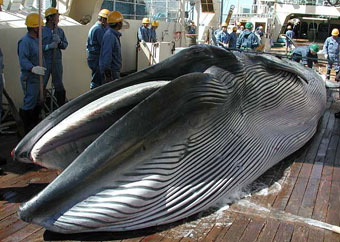 This
week he is tackling much bigger game: Japan's attempts to
resume a whaling program. So weigh anchor on the Pequod
- the Captain meets with Japan's Institute of Cetacean Research.
This
week he is tackling much bigger game: Japan's attempts to
resume a whaling program. So weigh anchor on the Pequod
- the Captain meets with Japan's Institute of Cetacean Research.
The photo features thousands
of silver Japanese anchovy spilling from what looks like a
white sack into an orange plastic bucket. To most, each fish
is merely a potential option for dangling from the end of
a hook.
But to Japanese cetacean researchers, the meaning
goes far beyond simple bait.
The photo is from the publication JARPN II,
a summary report detailing findings of Japan's whaling research
team in a section of the North Pacific during 2002 and 2003.
Further, the sack is in reality a sliced-open Byrde's
whale's stomach.
"Some of the things we are looking at
are the number of whales, what kind of food they eat, and
how much are they consuming," says Dr. Hiroshi Hatanaka,
Director General of Japan's Institute
of Cetacean Research, as he points at the bulging whale
stomach from his office in Tokyo's Chuo Ward.
Do whales eat significant quantities of fish
(in addition to plankton and krill)? The Institute's research
claims that the whales living in a selected research area
of the Pacific annually consume 2 million tons of anchovy,
a number ten times the catch of Japanese fisherman.
The Institute has produced literature that
says that consumption such as this is upsetting the balance
of the oceanic ecosystem - in other words, whales are eating
too many fish.
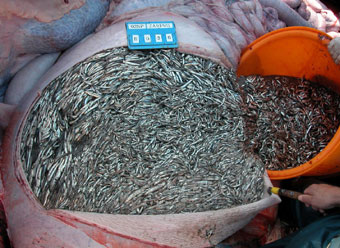 This
is simply one argument Japan uses in attempting to reach its
goal: to establish a "sustainable commercial harvesting"
of whales. It is a slow process, one that requires ample evidence
in convincing anti-whaling nations within the International
Whaling Commission that any future harpooning is harmless
to whale stocks. And with cultural differences complicating
the issue, the voyage to reach such a goal is a long one.
This
is simply one argument Japan uses in attempting to reach its
goal: to establish a "sustainable commercial harvesting"
of whales. It is a slow process, one that requires ample evidence
in convincing anti-whaling nations within the International
Whaling Commission that any future harpooning is harmless
to whale stocks. And with cultural differences complicating
the issue, the voyage to reach such a goal is a long one.
In 1986, the moratorium on commercial whaling
was established, essentially limiting the supply of whale
meat in Japan to that taken by its research whaling ships.
The research examines captured whales' digestive and reproductive organs, amongst other testing.
In addition, non-lethal sighting surveys and biopsy sampling provide
further information. Next year the Institute plans on taking
approximately 700 whales from the Antarctic and Pacific.
The meat from the catch then usually winds
up on dinner plates in the form of sashimi, bacon,
or marinated with soy sauce at some of Japan's higher end
restaurants. The proceeds fund 90% of the Institute's operating
budget with the government providing the remainder.
The data culled from this research since 1986
has shown that, Hatanaka says, "many of the whale resources
have increased, have rebounded."
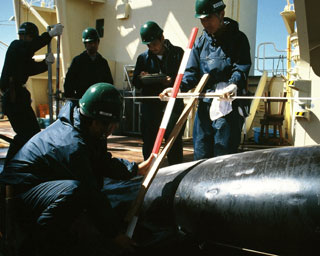 He
cites a number of species in the Pacific
as being "robust and abundant," specifically the
stock of 25,000 Minke whales that travels up to the Sea of
Okhotsk and the stock of 26,000 Bryde's that moves within
the warmer waters a bit further south.
He
cites a number of species in the Pacific
as being "robust and abundant," specifically the
stock of 25,000 Minke whales that travels up to the Sea of
Okhotsk and the stock of 26,000 Bryde's that moves within
the warmer waters a bit further south.
Hatanaka is quick to admit that there are many
whale resources that are in a critical situation as far as
abundance. But he maintains that overall the current reproduction
rates of all species will double the whale population around
the world in five years.
"We have a situation where we are protecting
whales. But they are animals; they reproduce," he says.
One of the Institute's motivating forces is
that Japan possesses a "whale food culture," a society
where whale hunting is a time-held custom that is depicted
in ukiyo-e woodblock prints from centuries ago. In
fact, newspaper advertisements of the Institute liken the
loss of the ability to eat whale meat with that of not being
able to eat pork or beef in Western societies.
Though whale meat is a delicacy in Japan today
and that harvesting whales (like one might for pigs or cattle)
is a near impossibility, Hatanaka maintains that the analogy
is reasonable given that Japan's older generation used to
eat whale throughout its childhood, with the younger generation
having generally been deprived of the experience. He says
that if whale meat were more readily available - and at a
more reasonable price - more and more people in Japan would
eat it, just like in the old days.
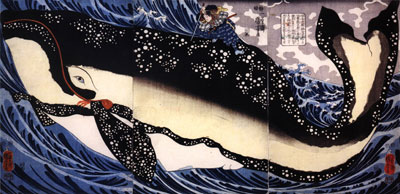 "In
the Edo Period (1603-1867), eating meat from animals with
hair was prohibited," Hatanaka says, citing Japan's Buddhist
principles. "For us Japanese, whales are perceived as
fish in a sense."
"In
the Edo Period (1603-1867), eating meat from animals with
hair was prohibited," Hatanaka says, citing Japan's Buddhist
principles. "For us Japanese, whales are perceived as
fish in a sense."
The harpooning of whales in Japan dates all
the way back to the 15th century, a time when the practice provided
a source of income for coastal regions. Though whaling
was suspended during World War II, Occupation forces allowed
Japan to restart whaling in the Antarctic when food shortages
became rampant. Because it was cheap, whale meat became a
basic food for Japan's poor.
But anti-whaling groups are not convinced that
resumption of whaling is possible.
Environmental group Greenpeace's
webpage states: "Overturning the ban on whaling would
be devastating to the world's whales, which are just beginning
to recover from years of exploitation. Whales mature and breed
slowly, thus populations are slow to recover. Furthermore,
whales are already jeopardised by a number of human induced
environmental threats, such as toxic pollution and climate
change."
But Hatanaka says that such groups are ignoring
science. He maintains: "Australia and New Zealand, the
staunchest anti-whaling countries, they know that not all
whale species are endangered. But they have a policy that
'no whaling' shall be permitted - no matter the reason."
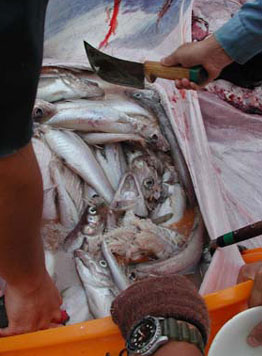 At
this year's IWC conference in Sorrento, Italy, Japan pushed
for a removal of the ban on commercial whaling and the elimination
of a whale sanctuary in the Antarctic Ocean. Though both were
voted down (a three-quarter majority is required for the amendment
of any rules and Japan presently has the support of roughly
half of the IWC members) Hatanaka is not discouraged; he knows
it is a long process. "Ten years ago, only a quarter
(of IWC members) supported sustainable whaling," he says.
At
this year's IWC conference in Sorrento, Italy, Japan pushed
for a removal of the ban on commercial whaling and the elimination
of a whale sanctuary in the Antarctic Ocean. Though both were
voted down (a three-quarter majority is required for the amendment
of any rules and Japan presently has the support of roughly
half of the IWC members) Hatanaka is not discouraged; he knows
it is a long process. "Ten years ago, only a quarter
(of IWC members) supported sustainable whaling," he says.
Hatanaka is pushing for whaling together with
research. "I don't know if it will take 20 or 30 years
but eventually commercial whaling will be resumed," he
says. "But it won't be like the past; it will have to
be very well regulated."
His vision for the Institute is clear.
"It is important to continue doing research,
to be able to establish the condition of the different stocks,
and to make people of the world understand that to use, on
a sustainable basis, marine resources, including whales, is
correct and important," Hatanoka says. "And that
we eventually succeed. Not that people agree with us, but
that they understand."
Note: All photos provided by Japan's Institute
of Cetacean Research.
The Whaling Series > Whale Consumption > Belly of the Whale

